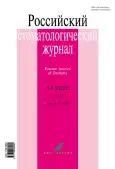Сравнение прочностных характеристик прямых и непрямых реставраций зубов при одноосном сжатии
- Авторы: Енина Ю.И.1, Севбитов А.В.1, Дорофеев А.Е.1, Ершов К.А.1, Пустохина И.Г.1
-
Учреждения:
- ФГАОУ ВО «Первый Московский государственный медицинский университет имени И.М. Сеченова» Минздрава России (Сеченовский университет)
- Выпуск: Том 24, № 5 (2020)
- Страницы: 293-296
- Раздел: Экспериментально-теоретические исследования
- URL: https://journals.rcsi.science/1728-2802/article/view/61022
- DOI: https://doi.org/10.17816/1728-2802-2020-24-5-293-296
- ID: 61022
Цитировать
Полный текст
Аннотация
Актуальная задача современной восстановительной терапевтической стоматологии — принятие в каждом конкретном клиническом случае решения, оправданного не только с эстетической и медицинской, но и экономической, а также биомеханической и эргономической точек зрения. По мнению многих авторов, залогом успешного восстановительного лечения дефектов твердых тканей любого генеза является понимание этиологических причин и условий их возникновения, а также оценка размеров дефекта и уровня материально-технической базы современной стоматологии.
Отдаленные результаты эстетического восстановления зубов прямым методом различными композитными материалами указали на допущение множественных ошибок и осложнений, таких как несоответствие цвета и прозрачности пломбы, нарушение краевого прилегания, появление краевого окрашивания по границе композитного материала с тканями зуба, как во время, так и в различные сроки после лечения.
В отличие от прямого метода реставрации, керамическую вкладку изготавливают непрямым методом. Это позволяет снизить полимеризационную усадку, что в свою очередь улучшает краевое прилегание и уменьшает частоту рецидивов кариеса.
Полный текст
Открыть статью на сайте журналаОб авторах
Ю. И. Енина
ФГАОУ ВО «Первый Московский государственный медицинский университет имени И.М. Сеченова» Минздрава России (Сеченовский университет)
Email: avsevbitov@mail.ru
Россия, 119992, Москва, ул. Трубецкая, д. 8, стр. 2
А. В. Севбитов
ФГАОУ ВО «Первый Московский государственный медицинский университет имени И.М. Сеченова» Минздрава России (Сеченовский университет)
Автор, ответственный за переписку.
Email: avsevbitov@mail.ru
Доктор медицинских наук, профессор, заведующий кафедрой
Россия, 119992, Москва, ул. Трубецкая, д. 8, стр. 2А. Е. Дорофеев
ФГАОУ ВО «Первый Московский государственный медицинский университет имени И.М. Сеченова» Минздрава России (Сеченовский университет)
Email: avsevbitov@mail.ru
Россия, 119992, Москва, ул. Трубецкая, д. 8, стр. 2
К. А. Ершов
ФГАОУ ВО «Первый Московский государственный медицинский университет имени И.М. Сеченова» Минздрава России (Сеченовский университет)
Email: avsevbitov@mail.ru
Россия, 119992, Москва, ул. Трубецкая, д. 8, стр. 2
И. Г. Пустохина
ФГАОУ ВО «Первый Московский государственный медицинский университет имени И.М. Сеченова» Минздрава России (Сеченовский университет)
Email: avsevbitov@mail.ru
Россия, 119992, Москва, ул. Трубецкая, д. 8, стр. 2
Список литературы
- Revazova ZE, Rizhinashvili TA. Clinical examination of patients in therapeutic dentistry. In: Dmitrieva LA, Maksimovsky YuM, editors. Therapeutic Dentistry: national guide. Moscow: GEOTAR-Media; 2009. p. 121–141. (In Russ).
- Dmitrieva LA, Bobr IS. Operational technique of dental treatment. In: Dmitrieva LA, Maksimovsky YuM, editors. Therapeutic Dentistry: national guide. Moscow: GEOTAR-Media; 2009. P. 359–391. (In Russ).
- Lebedenko IYu, Uzunyan NA. Prevention of errors in choosing the color of teeth. Rossiiskii stomatologicheskii zhurnal. 2005;(4):22–25. (In Russ).
- Garber DA. Aesthetic restoration of posterior teeth. Moscow: MEDpress-inform; 2009. 152 p. (In Russ).
- Wood I, Jawad Z, Paisley C, Brunton P. Non-carious cervical tooth surface loss: a literature review. J Dent. 2008;36(10):759–766. doi: 10.1016/j.jdent.2008.06.004.
- Aw TC, Lepe X, Johnson GH, Mancl L. Characteristics of noncarious cervical lesions: a clinical investigation. J Am Dent Assoc. 2002;133(6):725–733. doi: 10.14219/jada.archive.2002.0268.
- Francisconi LF, Graeff MS, de Moura Martins L., et al. The effects of occlusal loading on the margins of cervical restorations. J Am Dent Assoc. 2009;140(10):1275–1282. doi: 10.14219/jada.archive.2009.0051.
- Nascimento MM, Gordan VV, Qvist V, et al. Restoration of noncarious tooth defects by dentists in The Dental Practice-Based Research Network. J Am Dent Assoc. 2011;142(12):1368–1375. doi: 10.14219/jada.archive.2011.0138.
- Tyas MJ. The Class V lesion-aetiology and restoration. Aust Dent J. 1995;40(3):167–170. doi: 10.1111/j.1834-7819.1995.tb05631.x.
- da Conceição Dantas de Medeiros F, De Araújo-Silva TF, Alves Ferreira K, et al. Use of dental prostheses and their relationship with oral lesions. Rev Salud Publica (Bogota). 2015;17(4):603–613. (In Portuguese). doi: 10.15446/rsap.v17n4.34322.
- Sevbitov AV, Brago AS, Enina YuI. Experience of using hybrid ceramics for dental restoration in the cervical region. Klinicheskaya stomatologiya. 2017;(3):10–12. (In Russ).
- Nikolaev AI, Tsepov LM. Practical therapeutic dentistry. Treatment of caries: guide. Smolensk: SGMA Publishing house; 1999. 254 p. (In Russ).
- Della Bona A, Corazza PH, Zhang Y. Characterization of a polymer-infiltrated ceramic-network material. Dent Mater. 2014;30(5):564–569. doi: 10.1016/j.dental.2014.02.019.
- Enina YuI, Sevbitov AV, Dorofeev AE, Pustokhina IG. Assessment of the quality of the marginal fit of direct and indirect restorations in the cervical region of teeth. Zhurnal nauchnykh statei Zdorov'e i obrazovanie v XXI veke. 2019;21(6):27–30. (In Russ).








